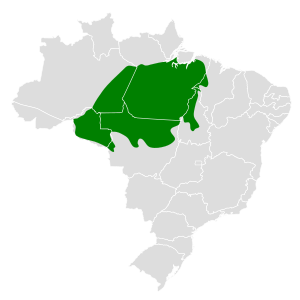Para gnatcatcher facts for kids
Quick facts for kids Para gnatcatcher |
|
|---|---|
| Scientific classification | |
 |
The Para gnatcatcher (Polioptila paraensis), sometimes called Klages's gnatcatcher, is a small bird. It is a species of bird in the family Polioptilidae. This bird lives only in Brazil.
Contents
A Unique Bird Species
The Para gnatcatcher is a monotypic species. This means it is the only member of its kind. For a long time, people thought it was a type of Guianan gnatcatcher (Polioptila guianensis). But since 2019, scientists have decided it is a separate species. They noticed differences in how it looks and the sounds it makes.
What Does the Para Gnatcatcher Look Like?
The Para gnatcatcher is a tiny bird. It is about 10 to 11 cm (3.9 to 4.3 in) long. That's about the length of a small pencil. It weighs around 6 g (0.21 oz), which is super light!
The male Para gnatcatcher has a gray head, back, and chest. The rest of its belly is white. Its throat, chest, and belly blend together smoothly. The feathers closest to its body on its tail are black. The feathers on the very outside of its tail are white. The feathers in between are a mix of black and white.
Female Para gnatcatchers look a lot like the males. However, their faces are a bit lighter in color.
Where Does the Para Gnatcatcher Live?
The Para gnatcatcher lives only in Brazil. You can find it in a wide area south of the Amazon River. This area stretches from the river's mouth almost all the way to northern Bolivia.
These birds like to live in humid primary forest. This means forests that have not been cut down or changed much by humans. They usually stay near the edges of these forests. They also like to live high up in the trees, in the canopy. Most of them live below 500 m (1,600 ft) in elevation.
Para Gnatcatcher Behavior
What Does the Para Gnatcatcher Eat?
We don't know a lot about what the Para gnatcatcher eats. But scientists think it eats arthropods. Arthropods are small creatures like insects and spiders. Other gnatcatchers in the Polioptila family also eat arthropods. The Para gnatcatcher is very active when it looks for food. It searches for food high up in the trees, in the canopy and just below it.
Reproduction and Life Cycle
Scientists have not yet studied how the Para gnatcatcher reproduces. This means we don't have much information about their breeding habits. We don't know when they lay eggs or how they raise their young.
What Does the Para Gnatcatcher Sound Like?
The song of the Para gnatcatcher is made of "repeated high...notes." It sings these notes at a steady pace. You can listen to an example of its song online here.
Conservation Status
The IUCN (International Union for Conservation of Nature) has not yet checked on the Para gnatcatcher. This means it doesn't have an official conservation status. We don't know if it is endangered or not. One of the forest areas where this bird lives is called the Tocantins/Pindare moist forest. This area is thought to be at serious risk.
See also
 In Spanish: Perlita de Pará para niños
In Spanish: Perlita de Pará para niños

